Wingtip device
Wingtip devices are intended to improve the efficiency of fixed-wing aircraft by reducing drag.[1] Although there are several types of wing tip devices which function in different manners, their intended effect is always to reduce an aircraft's drag by partial recovery of the tip vortex energy. Wingtip devices can also improve aircraft handling characteristics and enhance safety for following aircraft. Such devices increase the effective aspect ratio of a wing without greatly increasing the wingspan. Extending the span would lower lift-induced drag, but would increase parasitic drag and would require boosting the strength and weight of the wing. At some point, there is no net benefit from further increased span. There may also be operational considerations that limit the allowable wingspan (e.g., available width at airport gates).

.svg.png)
Wingtip devices increase the lift generated at the wingtip (by smoothing the airflow across the upper wing near the tip) and reduce the lift-induced drag caused by wingtip vortices, improving lift-to-drag ratio. This increases fuel efficiency in powered aircraft and increases cross-country speed in gliders, in both cases increasing range.[1] U.S. Air Force studies indicate that a given improvement in fuel efficiency correlates directly with the causal increase in the aircraft's lift-to-drag ratio.[2]
Early history
Wing end-plates
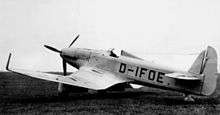
The initial concept dates back to 1897, when English engineer Frederick W. Lanchester patented wing end-plates as a method for controlling wingtip vortices.[3] In the United States, Scottish-born engineer William E. Somerville patented the first functional winglets in 1910. Somerville installed the devices on his early biplane and monoplane designs.[4] Vincent Burnelli received US Patent no: 1,774,474 for his "Airfoil Control Means" on August 26, 1930.[5]
Hoerner wing tips
.jpg)
Following the end of World War II, Dr. Sighard F. Hoerner was a pioneer researcher in the field, having written a technical paper published in 1952[6] that called for drooped wingtips whose pointed rear tips focused the resulting wingtip vortex away from the upper wing surface. Drooped wingtips are often called "Hoerner tips" in his honor. Gliders and light aircraft have made use of Hoerner tips for many years.[7][6]
The earliest-known implementation of a Hoerner-style downward-angled "wingtip device" on a jet aircraft was during World War II. This was the so-called "Lippisch-Ohren" (Lippisch-ears), allegedly attributed to the Messerschmitt Me 163's designer Alexander Lippisch, and first added to the M3 and M4 third and fourth prototypes of the Heinkel He 162A Spatz jet light fighter for evaluation. This addition was done in order to counteract the dutch roll characteristic present in the original He 162 design, related to its wings having a marked dihedral angle. This became a standard feature of the approximately 320 completed He 162A jet fighters built, with hundreds more He 162A airframes going unfinished by V-E Day.[8]
Winglet
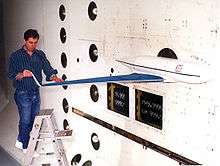
The term "winglet" was previously used to describe an additional lifting surface on an aircraft, like a short section between wheels on fixed undercarriage. Richard Whitcomb's research in the 1970s at NASA first used winglet with its modern meaning referring to near-vertical extension of the wing tips.[9] The upward angle (or cant) of the winglet, its inward or outward angle (or toe), as well as its size and shape are critical for correct performance and are unique in each application. The wingtip vortex, which rotates around from below the wing, strikes the cambered surface of the winglet, generating a force that angles inward and slightly forward, analogous to a sailboat sailing close hauled. The winglet converts some of the otherwise-wasted energy in the wingtip vortex to an apparent thrust. This small contribution can be worthwhile over the aircraft's lifetime, provided the benefit offsets the cost of installing and maintaining the winglets.
Another potential benefit of winglets is that they reduce the intensity of wake vortices.[10] Those trail behind the plane and pose a hazard to other aircraft.[11] Minimum spacing requirements between aircraft operations at airports are largely dictated by these factors. Aircraft are classified by weight (e.g. "Light," "Heavy," etc.) because the vortex strength grows with the aircraft lift coefficient, and thus, the associated turbulence is greatest at low speed and high weight, which produced a high angle of attack.
Winglets and wingtip fences also increase efficiency by reducing vortex interference with laminar airflow near the tips of the wing,[12] by 'moving' the confluence of low-pressure (over wing) and high-pressure (under wing) air away from the surface of the wing. Wingtip vortices create turbulence, originating at the leading edge of the wingtip and propagating backwards and inboard. This turbulence 'delaminates' the airflow over a small triangular section of the outboard wing, which destroys lift in that area. The fence/winglet drives the area where the vortex forms upward away from the wing surface, since the center of the resulting vortex is now at the tip of the winglet.
Aircraft such as the Airbus A340 and the Boeing 747-400 use winglets while other designs such as later versions of the Boeing 777 and the Boeing 747-8 have raked wingtips. The fuel economy improvement from winglets increases with the mission length.[13] Blended winglets allow a steeper angle of attack reducing takeoff distance.[14]
Early NASA development
Richard T. Whitcomb, an engineer at NASA's Langley Research Center, further developed Hoerner's concept in response to the sharp increase in the cost of fuel after the 1973 oil crisis. With careful aeronautical design, he showed that correctly angled and shaped winglets could maintain the same or lower bending moment with a smaller wingspan and greater flight stability than tip extensions. Whitcomb's designs were flight-tested in 1979–80 by a joint NASA/Air Force team, using a KC-135 Stratotanker based at the Dryden Flight Research Center.[3] A Lockheed L-1011 and McDonnell Douglas DC-10 were also used for testing, and the latter design was directly implemented by McDonnell Douglas on the derivative MD-11, which was rolled out in 1990.[3] NASA's own most notable application of wingtip devices is on the Boeing 747 Shuttle Carrier Aircraft. Located on the 747's horizontal stabilizers, the devices increase the tailplane's effectiveness under the weight of the Space Shuttle orbiter,[9] though these were more for directional stability than for drag reduction.
Applications
Homebuilt
The Rutan VariEze, a homebuilt aircraft design by Burt Rutan, made its first flight on May 21, 1975, before NASA winglet flight tests. The canard aircraft rudders and vertical stabilizers are at the extremities of the swept wing and could function as winglets. It pioneered glass-reinforced plastic composite construction in homebuilt aircraft, simplifying winglet fabrication. The derivative Rutan Long-EZ have a similar configuration.
Business aircraft

Learjet exhibited the prototype Learjet 28 at the 1977 National Business Aviation Association convention. It employed the first winglets ever used on a production aircraft, either civilian or military. Learjet developed the winglet design without NASA assistance. Although the Model 28 was intended to be a prototype experimental aircraft, performance was such that it resulted in a production commitment from Learjet. Flight tests showed that the winglets increased range by about 6.5 percent and improved directional stability. Learjet's application of winglets to production aircraft continued with newer models including the Learjet 55, 31, 60, 45, and Learjet 40.
Gulfstream Aerospace explored winglets in the late 1970s and incorporated winglets in the Gulfstream III, Gulfstream IV and Gulfstream V. The Gulfstream V range of 6,500 nmi (12,000 km) allows nonstop routes such as New York–Tokyo, it holds over 70 world and national flight records.[3] The Rutan combined winglets-vertical stabilizer appeared on his Beechcraft Starship business aircraft design that first flew in 1986.
Winglets are also applied to other business aircraft, reducing take-off distance to operate from smaller airports, and allowing higher cruise altitudes. Along winglets on new designs, aftermarket vendors developed retrofits. Winglet Technology, LLC of Wichita, Kansas should have tested its elliptical winglets designed to increase payload-range on hot and high departures to retrofit the Citation X.[15]
Experimental
Conventional winglets were fitted to Rutan's Rutan Voyager, the first aircraft to circumnavigate the world without refueling in 1986. The aircraft's wingtips were damaged, however, when they dragged along the runway during takeoff, grinding off about 1 foot (30 cm) of each wingtip, so the flight was made without benefit of winglets.[16]
Airliners
Wingtip fence
A wingtip fence refers to the winglets including surfaces extending both above and below the wingtip, as described in Whitcomb's early research.[9] Both surfaces are shorter than or equivalent to a winglet possessing similar aerodynamic benefits. The Airbus A310-300 was the first airliner with wingtip fences in 1985.[17] It was followed by the A300-600, the A320, and the A380. The A320 Enhanced, A320neo, A350 and A330neo have blended winglets rather than wingtip fences. The An-148 uses wingtip fences.
Canted winglets
Boeing announced a new version of the 747 in October 1985, the 747-400 introduced in 1989, with an extended range and capacity, using a combination of winglets and increased span to carry the additional load. The winglets increased the 747-400's range by 3.5% over the 747-300, which is otherwise aerodynamically identical but has no winglets.[1] Winglets are preferred for Boeing derivative designs based on existing platforms, because they allow maximum re-use of existing components. Newer designs are favoring increased span, other wingtip devices or a combination of both, whenever possible.
The Ilyushin Il-96 was the first Russian and modern jet to feature winglets in 1988. The Bombardier CRJ-100/200 was the first regional airliner to feature winglets in 1992. The A340/A330 followed with canted winglets in 1993/1994. The Tupolev Tu-204 was the first narrowbody aircraft to feature winglets in 1994. The Airbus A220 (née CSeries), from 2016, has canted winglets.
Blended winglets
A blended winglet is attached to the wing with a smooth curve instead of a sharp angle and is intended to reduce interference drag at the wing/winglet junction. A sharp interior angle in this region can interact with the boundary layer flow causing a drag inducing vortex, negating some of the benefit of the winglet. Seattle-based Aviation Partners develops blended winglets as retrofits for the Gulfstream II, Hawker 800 and the Falcon 2000.
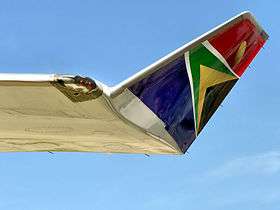 Boeing 747-400 canted winglet
Boeing 747-400 canted winglet.jpg) Airbus A320 sharklet
Airbus A320 sharklet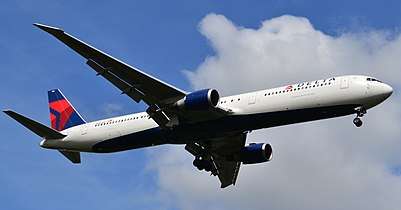 Boeing 767-400ER with raked wingtips
Boeing 767-400ER with raked wingtips Airbus A310 wingtip fence
Airbus A310 wingtip fence
On 18 February 2000, blended winglets were announced as an option for the Boeing 737-800; the first shipset was installed on 14 February 2001 and entered revenue service with Hapag-Lloyd Flug on 8 May 2001.[18] The Aviation Partners/Boeing 8 ft (2.4 m) extensions decrease fuel consumption by 4% for long-range flights and increase range by 130 or 200 nmi (240 or 370 km) for the 737-800 or the derivative Boeing Business Jet as standard.[1] Also offered for the 737 Classic, many operators have retrofitted their fleets with these for the fuel savings. Aviation Partners Boeing also offers blended winglets for the 757 and 767.[19] In 2006 Airbus tested two candidate blended winglets, designed by Winglet Technology and Airbus for the Airbus A320 family.[20] In 2009 Airbus launched its "Sharklet" blended winglet, designed to enhance the payload-range of its A320 family and reduce fuel burn by up to 4% over longer sectors.[21] This corresponds to an annual CO2 reduction of 700 tonnes per aircraft.[22] The A320s fitted with Sharklets were to be delivered from 2012.[23] They are used on the A320neo, the A330neo and the A350. They are also offered as a retrofit option.
Raked wingtip
Raked wingtips, where the tip has a greater wing sweep than the rest of the wing, are featured on some Boeing Commercial Airplanes to improve fuel efficiency, takeoff and climb performance. Like winglets, they increase the effective wing aspect ratio and diminish wingtip vortices, decreasing lift-induced drag. In testing by Boeing and NASA, they reduce drag by as much as 5.5%, compared to 3.5% to 4.5% for conventional winglets.[1] While an increase in span would be more effective than a same-length winglet, its bending moment is greater. A 3 ft (91 cm) winglet gives the performance gain of a 2 ft (61 cm) span increase but has the bending force of a 1 ft (30 cm) span increase.[24]
The short-range Boeing 787-3 would have had a 170 ft (51.7 m) wingspan to fit in ICAO Aerodrome Reference Code D.[25] Its wingspan was decreased by using blended winglets instead of raked wingtips.
Raked wingtips are installed on the Boeing 767-400ER (first flight on October 9, 1999), the Boeing 777-200LR/300ER/Freighter (February 24, 2003), the 737-derived Boeing P-8 Poseidon (25 April 2009), the Boeing 787-8/9/10 (December 15, 2009), the Boeing 747-8 Intercontinental and Freighter (February 8, 2010) and will be on the Boeing 777X planned for 2019. The Embraer E-jet E2 wing has a raked wingtip.
Split-tip
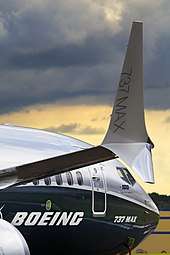
The McDonnell Douglas MD-11 was the first aircraft with split scimitar winglets in 1990.
The Boeing 737 MAX uses a new type of wingtip device.[26] Resembling a three-way hybrid between a winglet, wingtip fence, and raked wingtip, Boeing claims that this new design should deliver an additional 1.5% improvement in fuel economy over the 10-12% improvement already expected from the 737 MAX.
For the 737 Next Generation, Aviation Partners Boeing has introduced a similar design to the 737 MAX wingtip device known as the Split Scimitar Winglet,[27] with United Airlines as the launch customer.[28]
Gliders
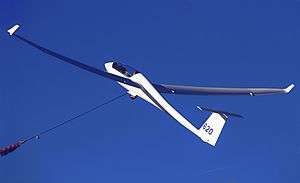
In 1987, mechanical engineer Peter Masak called on aerodynamicist Mark D. Maughmer, an associate professor of aerospace engineering at the Pennsylvania State University, about designing winglets to improve performance on his 15-meter (49 ft) wingspan racing sailplane. Others had attempted to apply Whitcomb's winglets to gliders before, and they did improve climb performance, but this did not offset the parasitic drag penalty in high-speed cruise. Masak was convinced it was possible to overcome this hurdle.[29] By trial and error, they ultimately developed successful winglet designs for gliding competitions, using a new PSU–90–125 airfoil, designed by Maughmer specifically for the winglet application. At the 1991 World Gliding Championships in Uvalde, Texas, the trophy for the highest speed went to a winglet-equipped 15-meter class limited wingspan glider, exceeding the highest speed in the unlimited span Open Class, an exceptional result.[30] Masak went on to win the 1993 U.S. 15 Meter Nationals gliding competition, using winglets on his prototype Masak Scimitar.[31]
The Masak winglets were originally retrofitted to production sailplanes, but within 10 years of their introduction, most high-performance gliders were equipped from the factory with winglets or other wingtip devices.[32] It took over a decade for winglets to first appear on a production airliner, the original application that was the focus of the NASA development. Yet, once the advantages of winglets were proven in competition, adoption was swift with gliders. The point difference between the winner and the runner-up in soaring competition is often less than one percent, so even a small improvement in efficiency is a significant competitive advantage. Many non-competition pilots fitted winglets for handling benefits such as increased roll rate and roll authority and reduced tendency for wing tip stall. The benefits are notable, because sailplane winglets must be removable to allow the glider to be stored in a trailer, so they are usually installed only at the pilot's preference.
The Glaser-Dirks DG-303, an early glider derivative design, incorporating winglets as factory standard equipment.
Non-planar wingtip
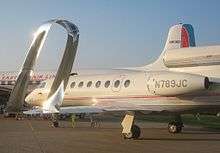
Aviation Partners developed and flight tested a closed-surface Spiroid winglet on a Falcon 50 in 2010.[33]
Non-planar wingtips are normally angled upwards in a polyhedral wing configuration, increasing the local dihedral near the wing tip, with polyhedral wing designs themselves having been popular on free-flight model aircraft designs for decades. Non-planar wingtips provide the wake control benefit of winglets, with less parasitic drag penalty, if designed carefully. The non-planar wing tip is often swept back like a raked wingtip and may also be combined with a winglet. A winglet is also a special case of a non-planar wingtip.
Aircraft designers employed mostly planar wing designs with simple dihedral after World War II, prior to the introduction of winglets. With the wide acceptance of winglets in new sailplane designs of the 1990s, designers sought to further optimize the aerodynamic performance of their wingtip designs. Glider winglets were originally retrofitted directly to planar wings, with only a small, nearly right-angle, transition area. Once the performance of the winglet itself was optimized, attention was turned to the transition between the wing and winglet. A common application was tapering the transition area from the wing tip chord to the winglet chord and raking the transition area back, to place the winglet in the optimal position. If the tapered portion was canted upward, the winglet height could also be reduced. Eventually, designers employed multiple non-planar sections, each canting up at a greater angle, dispensing with the winglets entirely.
The Schempp-Hirth Discus-2 and Schempp-Hirth Duo Discus use non-planar wingtips.
Actuating wingtip devices
There has been research into actuating wingtip devices, including a filed patent application,[34] though no aircraft currently uses this feature as described. The XB-70 Valkyrie's wingtips were capable of drooping downward in flight, to facilitate Mach 3 flight using waveriding.
Use on rotating blades
Wingtip devices are also used on rotating propeller, helicopter rotor, and wind turbine blades to reduce drag, reduce diameter, reduce noise and/or improve efficiency. By reducing aircraft blade tip vortices interacting with the ground surface during taxiing, takeoff, and hover, these devices can reduce damage from dirt and small stones picked up in the vortices.[35]
- "Winged rotor" on AgustaWestland AW101 Merlin helicopter
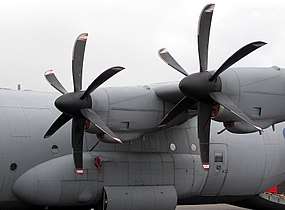 C-130J Super Hercules showing scimitar propellers with raked tips
C-130J Super Hercules showing scimitar propellers with raked tips- Detail view of the wingtip device on a wind turbine rotor-blade
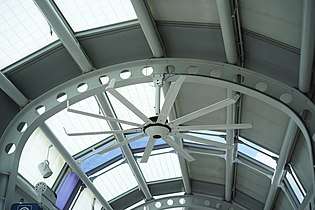 Ceiling fan with wingtip devices
Ceiling fan with wingtip devices
Rotorcraft applications
.jpg)
The main rotor of the AgustaWestland AW101 (formerly the EH101) has a special "winged tip"; pilots have found that this alters the downwash field and reduces brownout which limits visibility in dusty areas and leads to accidents.[36]
Propeller applications
Hartzell Propeller developed their "Q-tip" propeller used on the Piper PA-42 Cheyenne and several other fixed-wing aircraft types by bending the blade tips back at a 90-degree angle to get the same thrust from a reduced diameter propeller disk; the reduced propeller tip speed reduces noise, according to the manufacturer.[35] Modern scimitar propellers have increased sweepback at the tips, resembling a raked tip on an aircraft wing.
Other applications
Some ceiling fans have wingtip devices. Fan manufacturer Big Ass Fans has claimed that their Isis fan, equipped with wingtip devices, has superior efficiency.[37] However, for certain high-volume, low-speed designs, wingtip devices may not improve efficiency.[38] Another application of the same principle was introduced to the keel of the "America's Cup"- winning Australian yacht Australia II of 1982, designed by Ben Lexcen.
References
- Robert Faye, Robert Laprete, Michael Winter (January 2002). "Blended winglets for improved airplane performance" (PDF). Aero magazine. No. 17. Boeing.CS1 maint: multiple names: authors list (link)
- Committee on Assessment of Aircraft Winglets for Large Aircraft Fuel Efficiency (2007). Assessment of Wingtip Modifications to Increase the Fuel Efficiency of Air Force Aircraft. Air Force Studies Board - Division on Engineering and Physical Sciences. National Academies Press. p. 33. ISBN 978-0-309-38382-0.
- Joseph R. Chambers (2003). "Winglets" (PDF). Concept to Reality: Contributions of the Langley Research Center to US Civil Aircraft of the 1990s. NASA Langley Research Center. p. 35. ISBN 1493656783.
- "2010 Inductees". Illinois Aviation Hall Of Fame. William E. "Billie" Somerville 1869-1950.
- US 1774474, Vincent J Burnelli, "Airfoil control means", published 26 Aug 1930
- Hoerner, Dr. Sighard (1952). "Aerodynamic Shape of the Wing Tips" (PDF). USAF Technical Reports. Engineering Division, Air Materiel Command; Wright-Patterson Air Force Base, Dayton, Ohio; United States Air Force archive. Technical Report No. 5752. Archived (PDF) from the original on 2013-03-16.
- David Sakrison. "A German aerodynamicist, a California character, and a corkscrew". Met-Co-Aire.
- Creek, J. Richard; Conway, William (1967 (reprinted 1972).). The Heinkel He 162 (Aircraft in Profile number 203). Leatherhead, Surrey UK: Profile Publications Ltd. p. 5. Retrieved June 18, 2014. Check date values in:
|date=(help) - Bargsten, Clayton J.; Gibson, Malcolm T. (August 2011). NASA Innovation in Aeronautics: Select Technologies That Have Shaped Modern Aviation (PDF). National Aeronautics and Space Administration. pp. 11–22.
- Richard T. Witcomb (1976), A design approach and selected wind-tunnel results at high subsonic speeds for wing-tip mounted winglets (PDF), NASA
- "Chapter 2" (PDF), London City Airport Wake Turbulence Study, Halcrow Group Limited, December 2010, archived from the original on 2017-10-01CS1 maint: BOT: original-url status unknown (link)
- Phil Croucher (2005). Jar Professional Pilot Studies. Electrocution. pp. 2–11. ISBN 978-0-9681928-2-5.
- William Freitag, Terry Schulze (Summer 2009). "Blended Winglets Improve Performance" (PDF). Aero quarterly. Boeing. pp. 9–12.
- "Winglets allow for steeper climbs" (PDF). FACC AG. Archived from the original (PDF) on 2017-11-07. Retrieved 2019-01-06.
- "Winglets Coming For Citation X Bizjets". Aero news network. March 13, 2007.
- "Dick Rutan, Jeana Yeager, and the Flight of the Voyager". U.S. Centennial of Flight Commission.
- "From the A300 to the A380: Pioneering leadership". Corporate information - Innovation & technology. Airbus. Archived from the original on 2009-04-21.CS1 maint: BOT: original-url status unknown (link)
- "Next-Generation 737 Program Milestones". Boeing. Archived from the original on 2008-04-29. Retrieved 2019-02-05.
- Guy Norris (February 23, 2009). "American Airlines Set To Debut 767 Winglet Mod". Aviation Week & Space Technology. p. 39.
- "Industry Wrap". Frontiers. 4 (10). Boeing. March 2006. Airbus to test new winglets for single-aisle jetliners.
- "American Airlines takes delivery of its first A320 Family aircraft" (Press release). Airbus. 23 July 2013.
- "Korean Air Aerospace to manufacture and distribute Sharklets" (Press release). Airbus. 31 May 2010.
- "Airbus launches "Sharklet" large wingtip devices for A320 Family with commitment from Air New Zealand". Airbus. 15 November 2009. Archived from the original on 7 November 2017.
- George C. Larson (September 2001). "How Things Work: Winglets". Air & Space Magazine. Smithsonian.
- Rich Breuhaus (20 May 2008). "787 Dreamliner: A New Airplane for a New World" (PDF). ACI-NA Commissioners Conference. Boeing. Archived from the original (PDF) on 2017-03-07. Retrieved 2019-01-06.
- Matt Molnar (2 May 2012). "Boeing Says Radical New Winglets on 737 MAX Will Save More Fuel". NYCAviation.
- "737-800-3". Aviation Partners Boeing.
- "United is first to install Split Scimitar winglets" (Press release). United Airlines. July 17, 2013.
- Curtis Chan (Summer 2000). "The tip of the iceberg". Engineering Penn State magazine. Archived from the original on 2004-06-11.CS1 maint: BOT: original-url status unknown (link)
- Masak, Peter (April–May 1992). "Winglet Design for Sailplanes" (PDF). Free Flight. 1992 (2): 8. ISSN 0827-2557.
- "Past Mifflin Contests". Mifflin Soaring Association.
- Mark D. Maughmer (June 2002). "About Winglets" (PDF). Soaring Magazine.
- "Types of blended winglets". Aviation Partners.
- EP 1531126, Jan Irving & Robert Davies, "Wing tip device", published 2005-05-18, assigned to Airbus
- "What is a Q-Tip propeller? What are its advantages?". Product Support: Frequently Asked Questions. Hartzell Propeller. Archived from the original on 2001-03-18.
Aerodynamic improvements include a reduced diameter and decreased tip speeds. This results in quieter operation and reduced tip vortices. The 90° bend reduces the vortices that, on traditional blades, pick up debris that can contact the blades and cause nicks, gouges and scratches.
CS1 maint: BOT: original-url status unknown (link) - Harvey, Gareth (November 28, 2005). "Super Chopper : Life-Saving Features: No More Brown-Outs". Engineering Archives. National Geographic Channel. Archived from the original on July 21, 2009. Retrieved August 1, 2009.
To counteract this, the EH101's 'winged-tip' rotor blades create what its pilots call the "donut effect" – a circular window of clear air inside the dust storm that allows them to see the ground as they come in to land.
- Nino Machetti (May 10, 2010). "Isis ceiling fan claims higher efficiency". EarthTechling.
- Eddie Boyd (February 4, 2014). "Winglets: Help or Hindrance to HVLS Fan Performance?". MacroAir.
External links
| Wikimedia Commons has media related to Wingtip devices (aircraft wings). |
- Peter Masak (1991). "Winglet Design for Sailplanes".
- Martin Hepperle (May 1993). "A close Look at Winglets". International Nurflügelmeeting des MFC Osnabrück.
- "Winglet benefits". Flight International. 1 May 1996. Winglets could bring operational benefits to the Boeing 747-200F.
- "New Boeing 777-300ER Bristles with Technology" (Press release). Boeing. Oct 16, 2003.
- Joe Yoon (2 November 2003). "Boeing 767 Raked Wingtips". Aerospaceweb.org.
- "Winglets: making their presence felt" (PDF). Aircraft Technology Engineering & Maintenance. April–May 2004.
- Doug McLean (2005). "Wingtip Devices: What They Do and How They Do It" (PDF). Performance and Flight Operations Engineering Conference. Boeing.
- "The benefits of winglets and performance enhancing kits" (PDF). Aircraft Commerce. No. 109. December 2016 – January 2017.

.jpg)